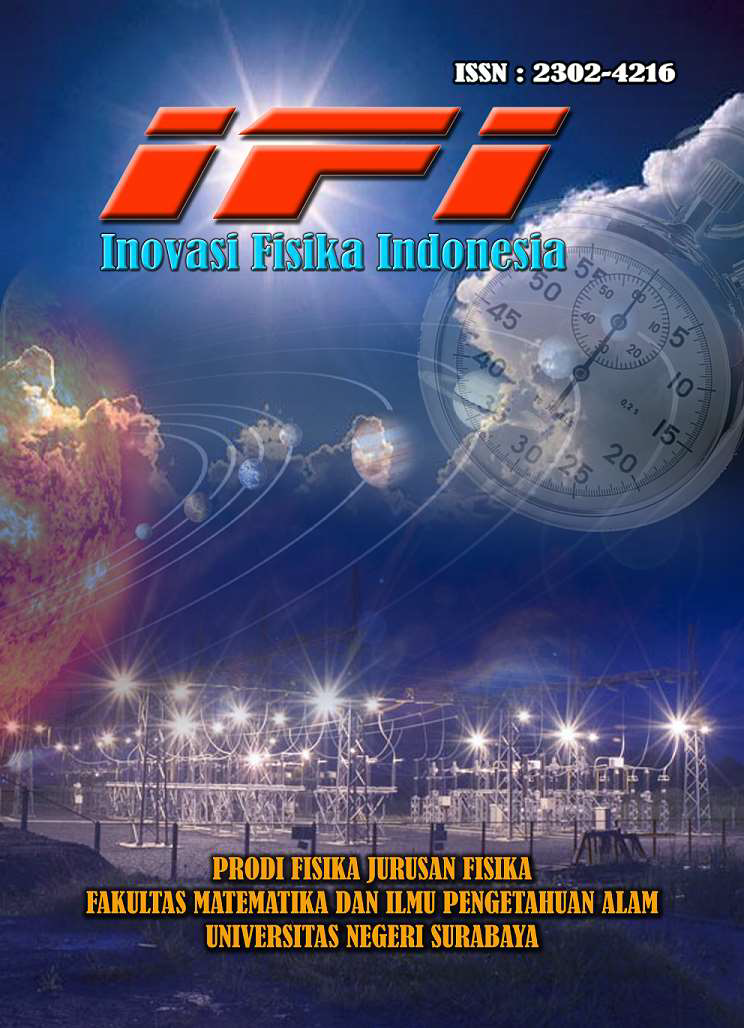KARAKTERISTIK FREKUENSI RESONANSI DAN OUTPUT POWER KERAMIK Mg(Ti0,98Cr0,02)O3 SEBAGAI MATERIAL RESONATOR PADA MODUL DIELECTRIC RESONATOR OSCILLATOR (DRO)
Kata Kunci: Keramik MTC002, frekuensi resonansi, output power, dan DRO.
DOI:
https://doi.org/10.26740/ifi.v13n2.p119-127Abstract
Magnesium titanate (MgTiO3) merupakan salah satu material dielectric resonator (DR) yang potensial untuk diaplikasikan pada berbagai sistem telekomunikasi, salah satunya sebagai komponen pembangkit frekuensi resonansi pada modul dielectric resonator oscillator (DRO) untuk aplikasi sistem radar. Terkait hal tersebut, makalah ini melaporkan karakteristik frekuensi resonansi dan output power keramik Mg(Ti0,98Cr0,02)O3 (disingkat MTC002) ketika keramik tersebut diujicobakan sebagai resonator pada modul DRO. Keramik dikompaksi menggunakan uniaxial-cylindrical-die press berdiameter 8 mm dan hydraulic-handpress pada tekanan 10 MPa, serta disinter pada suhu 1200 °C selama 4 jam. Tujuannya adalah untuk mengkaji karakteristik frekuensi resonansi DRO dan output power keramik serta mengkaitkannya dengan data struktur, mikrostruktur, dan permitivitas relatif. Resonansi DRO terdeteksi pada frekuensi 3,352 GHz dengan output power +3,848 dBm. Keramik ini mengandung MgTiO3 sebagai fasa utama (81,38 %molar) dan sisanya TiO2 rutile tanpa disertai fasa sekunder MgTi2O5 atau Mg2TiO4. Permukaan keramik tampak padat dengan nilai densitas bulk 3,056 g/cm3 . Selain itu, keberadaan fasa MgTiO3 tersebut dikonfirmasi oleh data EDX yang hanya mengandung unsur Mg, Ti, Cr, dan O dengan rasio %atom masing-masing 17,608; 17,831; 0,263; dan 64,298 %. Sementara nilai rata-rata ɛr keramik yang diukur pada rentang frekuensi 2-4 GHz adalah 17,40. Hasil-hasil di atas menunjukkan bahwa keramik MTC002 memiliki sifat dielektrik (Er) yang mendukung untuk diaplikasikan sebagai material resonator pada DRO, khususnya daerah S-band (2-4 GHz).
Kata Kunci: Keramik MTC002, frekuensi resonansi, output power, dan DRO.
Abstract
Magnesium titanate (MgTiO3) is a resonator (DR) dielectric material that has the potential to be applied in various telecommunications systems, one of which is as a resonant frequency generator component in the dielectric resonator oscillator (DRO) module for radar system applications. In this regard, this paper reports the characteristics of the resonance frequency and output power of Mg(Ti0.98Cr0.02)O3 ceramic (abbreviated as MTC002) when the ceramic was tested as a resonator in the DRO module. The ceramics were compacted using a uniaxial-cylindrical-die press with a diameter of 8 mm and a hydraulic-hand-press at a pressure of 10 MPa, and sintered at a temperature of 1200 °C for 4 hours. The aim is to study the characteristics of the DRO resonance frequency and power output of ceramics and relate them to data structure, microstructure and relative permittivity. DRO resonance was detected at a frequency of 3.352 GHz with an output power of +3.848 dBm. This ceramic contains MgTiO3 as the main phase (81.38% molar) and the remainder is rutile TiO2 without the secondary phase MgTi2O5 or Mg2TiO4. The ceramic surface appears solid with a bulk density value of 3.056 g/cm3 . In addition, the existence of the MgTiO3 phase was confirmed by EDX data which only contains the elements Mg, Ti, Cr, and O with an atomic % ratio of 17.608; each 17.831; 0.263; and 64.298 %. Meanwhile, the average value for ceramics measured in the 2-4 GHz frequency range is 17.40. The results above show that MTC002 ceramic has dielectric properties (Er) that support its application as a resonator material in DRO, especially the S-band region (2-4 GHz).
Keywords: MTC002 ceramic, resonant frequency, output power, and DRO.
Downloads
Downloads
Published
How to Cite
Issue
Section
License
Copyright (c) 2024 Inovasi Fisika Indonesia

This work is licensed under a Creative Commons Attribution-NonCommercial 4.0 International License.
 Abstract views: 179
,
Abstract views: 179
, PDF Downloads: 151
PDF Downloads: 151








1.png)
